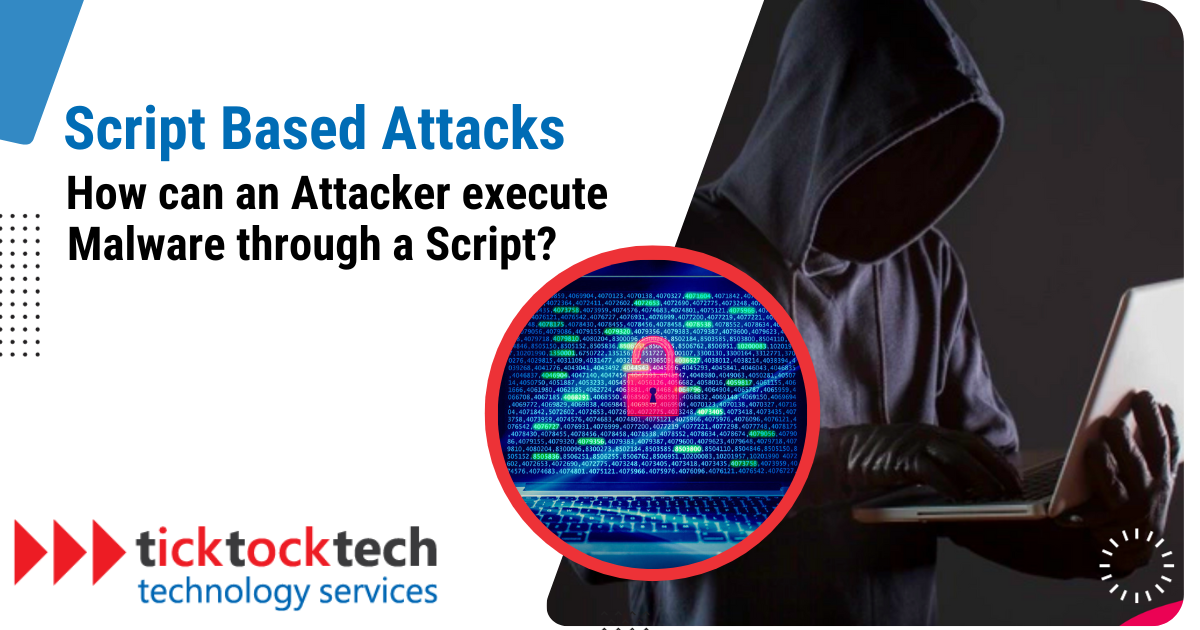Script-based attacks have become a major player in the world of cyberattacks, growing by more than 100% since around 2017. In fact, they now make up a whopping 40% of all cyber threats.
What makes these scripts so appealing to cybercriminals is their simplicity. They’re easy to create, effortless to use, and incredibly good at evading regular endpoint security tools.
In this article, we’re going to demystify script-based attacks. We’ll explain how they work, what they do, and most importantly, how you can protect yourself from them.
What are Script-Based Attacks?
Script-based attacks are a category of cyber threats where malicious actors leverage scripts or scripts embedded within legitimate files to exploit vulnerabilities, gain unauthorized access, or execute malicious actions directly in memory.
A script can take many forms, ranging from a series of basic system instructions to sophisticated scripting languages employed for configuring systems, automating intricate tasks, and other general purposes.
Popular scripting languages include VBScript, JavaScript, and PowerShell. Unlike applications that convert into machine code through compilation before they run, scripts are directly interpreted by computers.
Due to this nature of scripts, script-based attacks work without relying on traditional malicious files that occupy disk space. This makes them more challenging to detect using traditional antivirus or email/web security systems that primarily focus on file-based threats.
Related: Cybercrime and the types of computer access crimes
How Attackers Execute Malware Through Script
Following a successful initiation of a script-based infection, two key phases unfold: payload delivery and lateral movement.
In the first phase, the payload (the script) executes specific actions as directed by the attacker, including tasks like gathering information, encrypting files, or establishing secret communication channels.

Simultaneously, the second phase, lateral movement, involves spreading the infection to more computers within the network.
In a typical file-less script attack, the initial delivery method or attack vector often involves an email carrying a Word document containing a malicious macro.
When an unsuspecting victim interacts with this mail, the macro is activated. Once activated, the macro triggers a Visual Basic Script, which then initiates a concealed PowerShell task.
This PowerShell task connects to the internet and downloads a malware application, all of which transpires exclusively in a computer’s RAM. Remarkably, throughout this entire sequence, there is no trace of data being written to the hard disk.
Script-based attacks can operate on almost every Windows system, expanding the potential points of attack and elevating the risk of infection.
That said, there is one potential breakthrough point. Script-based attacks cannot be initiated autonomously. In other words, they depend on user interaction to initiate unless they exploit vulnerabilities.
Script-based Malware Attack Vectors
To execute malware via a script, attackers attach it to seemingly harmless programs, like Office documents or PDF files. Once this pairing is complete, the attackers then distribute these manipulated programs to their victims.
Common attack vectors for script-based malware attacks include:
- Email attachment and phishing — emails that prompt the user to take action or VBA macros embedded in documents that need the user’s permission to enable macros.
- Poserware — comes off as a legitimate PDF writer or a ZIP file tool but contains hidden scripts that can trigger the downloading of malware.
- Multimedia downloads — duplicitous downloads, such as software installers, documents, or multimedia files, that contain hidden script-based malware.
Alternatively, attackers utilize HTML Applications (HTA) and JavaScript to execute malware through scripts. When an HTA runs, it can exploit user privileges to carry out malicious actions.
Conversely, JavaScript code is commonly executed when cybercriminals entice users into visiting compromised websites. An infected JavaScript code allows attackers to exploit system vulnerabilities and ultimately gain control over the targeted device.
Related: Why is Data Security Important?
What type of Scripts are used for Script-based Malware Attacks?
Let’s quickly review the common types of scripts bad guys use to develop script-based malware.
1. JavaScript
JavaScript is a widely used scripting language employed in web pages, web applications, and browsers. With its capabilities, JavaScript can alter and enhance PDF files by incorporating various elements such as objects and web page links.
In many instances, PDF-based attacks leverage PDF reader software or in-browser readers to execute JavaScript code on the victim’s device.
2. Powers Shell
PowerShell serves as a versatile framework designed for configuration management and task automation, featuring both a command-line shell and a scripting language. It offers access to critical components like Microsoft Windows Management Instrumentation (WMI) and the Component Object Model (COM).
This dual capability makes it an invaluable tool not only for system administrators streamlining IT management tasks but also for malicious actors looking to exploit system vulnerabilities.
3. HTML Application
An HTML Application (HTA) is a specific type of file designed for use on Microsoft Windows systems, typically intended to run within the Internet Explorer browser. These files combine HTML code with scripts supported by Internet Explorer, such as VBScript or JScript.
What sets HTA files apart is their execution through the Microsoft HTA engine (mshta.exe), which operates with the user’s local privileges rather than the restricted privileges of Internet Explorer. This mshta.exe framework grants HTAs broader access to the file system and registry, making them a powerful tool in the Windows environment.
Malicious HTA files enable scripts to operate on a computer with the privileges of the local user. This allows them to download and execute executables or additional scripts.
Despite being an older attack method, HTA files remain in use within many script-based attacks. Attackers can distribute these files as email attachments, trigger their download through other scripts, or initiate them through redirects from harmful websites.
4. VBScript
VBScript, short for Microsoft Visual Basic Scripting Edition, is a scripting language developed by Microsoft, sharing its roots with VBA (Visual Basic for Applications).
While VBA is designed for comprehensive application development, VBScript focuses on simplified usage, primarily aimed at automating tasks for system administrators.
Similar to PowerShell, which serves analogous purposes, VBScript is often employed in script-based attacks. Attackers also appreciate Microsoft’s support for script encoding, particularly through VBE files, which adds to its appeal as a tool for malicious activities.
Related: Understanding and Removing Malware from Your Computer
How to Protect Yourself from Script-based Malware
Detection and prevention are ultimately the safest net when it comes to safeguarding your digital assets and data from malicious scripts.

Here are effective strategies and tools to help you mitigate the risks associated with script-based intrusions.
1. Anti-malware software
A reputable anti-malware or antivirus software is a critical component of your defense against script-based attacks. These tools employ a database of known malware signatures and behavioral analysis to detect malicious scripts.
When anti-malware software encounters a script with a matching signature or suspicious behavior, it can take action by quarantining or removing it, thereby preventing potential harm.
Continuous updates are also crucial, as new script-based threats emerge frequently. Software developers regularly release patches and updates to address new vulnerabilities.
Without these updates, your anti-malware software may miss new threats. Furthermore, real-time scanning ensures that scripts are scanned as they are executed, providing immediate protection.
2. Network security measures
Firewalls, intrusion detection systems (IDS), and web filtering solutions play pivotal roles in network security against script-based attacks.
- Firewalls are your system’s gatekeeper, monitoring incoming and outgoing traffic. Configured to block known malicious script sources and restrict access to sensitive resources, firewalls act as a barrier against potential threats.
- Intrusion Detection Systems analyze network traffic for unusual patterns or behaviors, identifying potential script-based attacks in progress. They trigger alerts or actions when suspicious activity is detected, allowing for rapid response.
- Web filtering solutions can block access to websites and domains associated with script-based malware distribution, reducing the likelihood of users inadvertently downloading malicious scripts.
3. User education and awareness
To be forewarned is to be forearmed. Basic awareness can be the greatest tool in your arsenal when it comes to combating these cyber threats.
Regular cybersecurity awareness training should cover topics such as recognizing phishing attempts, handling email attachments cautiously, and avoiding interactions with unfamiliar scripts or macros.
You must clearly define and consistently enforce security policies across all boards. And consistently enforced. These policies guide user behavior in relation to downloads, email handling, and the execution of scripts.
Creating a culture of security awareness among your workforce is a powerful defense mechanism against social engineering tactics employed in script-based attacks.
4. Patch management
Outdated and vulnerable systems face heightened vulnerability to cyber-attacks that originate from within the network perimeter. Nowadays, hackers can deploy malware through scripts and subsequently conduct internal network scans to pinpoint vulnerabilities and technical shortcomings.
Regular updates and patches issued by software vendors close these security holes, making it difficult for attackers to gain a foothold.
Implement vulnerability scanning to identify weaknesses in your systems proactively. In the same breath, prioritize patching based on the severity of vulnerabilities to minimize exposure to potential script-based attacks.
5. Application whitelisting
Application whitelisting involves defining a list of trusted scripts and applications that are permitted to run on your system. This proactive approach ensures that only authorized code executes, effectively blocking unapproved scripts from running.
As your organization’s needs change and new scripts are introduced, you must keep the whitelist updated to ensure the integrity of your security system.
An improperly managed whitelist can lead to security gaps or hinder legitimate operations.
6. Behavioral analysis
Advanced threat detection solutions go beyond signature-based approaches and employ behavioral analysis and machine learning.
These technologies can detect script-based attacks based on unusual behaviors. Even if a script has no known signature, these tools can identify anomalies and flag potential threats.
7. Regular backups
While not a direct prevention method, regular and secure data backups are a crucial component of your defense strategy.
In the event of a successful script-based attack, having up-to-date backups ensures you can recover your data without capitulating to ransom demands or suffering irreversible data loss.
Backup copies should be stored securely and tested regularly to ensure they can be restored effectively.
8. Incident response plan
Should all fail, a comprehensive incident response plan will help minimize the impact on your normal operations, ensuring a swift return to normalcy.
Your response plan should outline clear steps to take in case of an attack, including containment, eradication, and recovery procedures.
Frequently Asked Questions
Cybercriminals create malicious scripts by altering code packets. They then hide these scripts in legitimate websites, third-party scripts, and other places. This threatens the security of client-side web applications and web pages.
Script-based attacks involve the use of malicious scripts or code to compromise computer systems and networks, often exploiting vulnerabilities or tricking users into executing these scripts. These attacks can lead to various consequences ranging from data breaches to malware infections and unauthorized access.
Various threats, such as malware, phishing emails, malicious websites, and cybercriminals, can execute scripts as part of their tactics. These scripts may be used to compromise systems, steal data, or carry out other malicious actions.
Script types vary, and not all of them are harmful. Scripts from trusted websites are generally safe, but it’s essential to exercise caution when dealing with unfamiliar or suspicious sources, email attachments, and downloaded files. Adjust browser settings and employ security measures accordingly.
A common type of vulnerability that allows an attacker to execute a malicious script is known as “Cross-Site Scripting” or XSS. In XSS attacks, the attacker injects malicious scripts (usually JavaScript) into a web application.
When unsuspecting users interact with the compromised application, their browsers execute these scripts, giving the attacker access to sensitive data, session cookies, or the ability to perform actions on behalf of the user.
Script-Based Attacks & How Attackers Execute Malware Through A Script
When it comes to executing malware via scripts, the method depends on the specific type of malicious code employed by the attacker — most of which we’ve explored. Understanding the inner workings of these scripts and identifying effective defense strategies is key to safeguarding you and your organization against cyber threats.
If you’re concerned about script-based attacks or suspect your system is infected, reach out to us at TickTockTech for assistance. We’ll actively assist you in removing any malware from your system and implementing robust security measures to shield you from potential future attacks.

